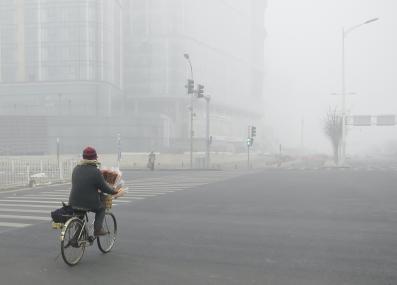Have a question?
How do clouds affect the Earth's temperature? Are humans changing clouds?
Clouds generally help cool the Earth. In recent decades, human pollution has created more clouds, which slightly counteracts global warming.
June 7, 2024
Big, puffy clouds generally have a cooling effect on the planet, blocking sunlight as it’s beamed to Earth and reflecting it back into space. But the overall cooling effect of clouds depends on how high in the sky they are, according to Daniel Cziczo, the Department Head of Earth, Atmospheric, and Planetary Sciences at Purdue University.
Stratus and cumulus clouds, which are low-hanging clouds, cool the planet. But wispy cirrus clouds, which form high in the atmosphere and are composed entirely of ice crystals, allow light to filter through and hit the Earth. When sunlight reflects off the globe, the extreme cold of cirrus clouds traps heat below. That quality makes these clouds unique. “The net effect of cirrus clouds is generally thought to be a warming of the planet, unlike really all of the other types of clouds that we typically consider,” says Cziczo.
Today, the number and nature of clouds are changing due to human actions. All types of clouds are composed of particles, which create the scaffolding that ice or water droplets latch on to. “If we didn't have particles in the atmosphere, it would be much, much more difficult to form clouds,” says Cziczo.
Because humans are emitting particulate matter from agriculture, power plants, and other polluting facilities, there are many more particles in the atmosphere than there were 200 years ago. Climate change itself even contributes: warmer temperatures have created the conditions for worse wildfires, for example, which then put even more particles in the air in the form of smoke.
Just how many particles have we added to the atmosphere? “Estimates are all over the place, but probably a doubling, maybe a tripling of particles, since pre-industrial times,” says Cziczo.
As a result, we’re seeing more clouds. Individual clouds also contain more particles, which makes them whiter and thicker, and capable of reflecting more sunlight into space. Overall, a larger number of more reflective clouds will help cool the planet. That could counteract some global warming, but only marginally, and scientists are still working to figure out exactly how much. “That's actually a very uncertain aspect of climate,” says Cziczo. “How much is that cooling? How much global warming is being offset by changes in particles and clouds?”
Part of the reason for this uncertainty is because clouds themselves are extremely complicated. Unlike climate-warming greenhouse gases, where both the sources and the impacts of the pollution are well understood, clouds are shaped by many variables besides the number of particles in the air. “We as scientists generally acknowledge that clouds are among—if not the most—uncertain part of the climate system,” says Cziczo. “We really right now are still working on a lot of the fundamental physics of cloud formation.”
Some scientists are even testing whether we could use the cooling power of clouds to help address climate change: for instance, by deliberately making clouds brighter and more reflective. But according to Cziczo, that’s a risky proposition. If deployed widely, those techniques could have “potentially catastrophic side effects,” he says, such as changing rainfall or damaging the ozone layer that protects us from the sun’s ultraviolet rays. “Geoengineering using particles and clouds is already on sort of a very dicey footing,” he says. “Trying to change something about the climate system by using the acknowledged most uncertain part of the climate system really doesn't make sense.” By contrast, he says, we understand how greenhouse gases are warming our planet very well—and getting that type of pollution under control is the simplest and safest way to overcome climate change.
Thank you to Benjamin Livonnen of France for the question.
Submit your own question to Ask MIT Climate
Get the latest from Ask MIT Climate monthly in your inbox







